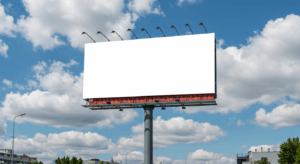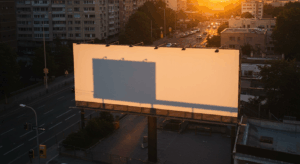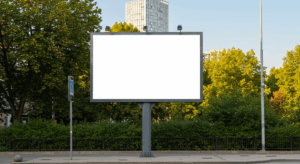From Highways to Walkable Streets: How Outdoor Advertising Adapts to Changing City Life
Urban landscapes are evolving. Many cities are shifting away from car-centric infrastructure toward walkable communities, mixed-use developments, and transit-heavy environments. As more areas prioritize pedestrian-friendly streets, public transit, and bike lanes, billboard advertising must adapt to new audience behaviors and movement patterns.
This blog explores how billboard strategies are evolving in pedestrian-heavy and transit-oriented cities, and how advertisers can maximize visibility in a world where foot traffic is just as important as vehicle traffic.
How Urban Design Changes Impact Billboard Advertising
As cities evolve, they introduce new challenges and opportunities for outdoor advertising. Traditional highway and roadside billboards remain essential, but pedestrian and transit-friendly environments require a different approach.
Key shifts affecting billboard placement and strategy:
✔ Fewer Cars, More Walkers – Pedestrian traffic increases as cities invest in car-free streets and bike-friendly areas.
✔ Transit Expansion – Bus and train ridership grows, making transit shelters, station billboards, and digital displays more valuable.
✔ Longer Dwell Time – In walkable areas, people spend more time near ads, allowing for more detailed messaging and interactive elements.
✔ Local vs. National Branding – Urban residents tend to support local businesses, making hyper-local messaging more effective.
By recognizing these changes, businesses can adapt their billboard strategy to remain relevant in an increasingly walkable, transit-oriented world.
The Shift from Highway Billboards to Urban Placements
While highway billboards still dominate long-distance and commuter-heavy routes, urban billboards in walkable neighborhoods, public squares, and mixed-use spaces are gaining traction.
| Factor | Highway Billboards | Urban Walkable Billboards |
|---|---|---|
| Audience | Commuters, long-distance travelers | Pedestrians, transit riders, cyclists |
| Viewing Time | 3-5 seconds (fast-moving traffic) | 10+ seconds (longer engagement) |
| Best Use Cases | Brand awareness, directional ads | Local business promotions, interactive ads |
| Design Strategy | Short, bold messaging | More detailed text, QR codes, interactive elements |
Both formats serve different but valuable roles—the key is choosing the right approach for each environment.
Key Strategies for Advertising in Pedestrian and Transit-Friendly Cities
With more people walking, cycling, and using public transportation, advertisers must adjust their billboard placement and messaging to align with new movement patterns.
1. Optimize Billboard Locations for Pedestrian Engagement
Pedestrian-friendly billboards should be placed in high-foot-traffic areas where people naturally slow down, stop, or gather.
Best billboard locations for pedestrian audiences:
✔ Downtown retail and shopping districts
✔ Outdoor plazas and entertainment zones
✔ Near train stations, subway entrances, and bus stops
✔ Parks, public squares, and tourist attractions
✔ Walkable university campuses
These locations allow for longer dwell time, increasing the likelihood that passersby will absorb and remember the message.
2. Adjust Messaging for a Slower-Paced Audience
Since pedestrians have more time to absorb an ad, billboard content can be more detailed than highway billboards.
✔ Include clear calls to action (e.g., “Scan for 10% Off Inside!”).
✔ Use localized messaging that connects with urban residents.
✔ Incorporate visuals that blend with the city’s culture and vibe.
Example: A café near a transit hub could use a billboard with:
“Missed Your Train? Grab a Coffee While You Wait.”
This type of timely, location-specific messaging resonates more in walkable environments.
3. Leverage Transit Advertising for Captive Audiences
Commuters on buses, trains, and subways are a captive audience, making transit-based billboards highly effective.
High-impact transit billboard placements include:
✔ Digital and static billboards inside train and bus stations
✔ Transit shelters where riders wait for buses
✔ Subway platform billboards, placed where passengers spend time
✔ Interior bus and subway ads targeting seated commuters
Transit riders often see the same ad repeatedly, reinforcing brand recall and message retention.
4. Use Interactive and Digital Elements
Walkable urban areas provide more opportunities for interactive advertising, including QR codes, augmented reality (AR), and digital billboards that can change based on time of day or audience demographics.
Examples of interactive billboard features:
✔ QR Codes: Pedestrians can scan for discounts, store directions, or exclusive offers.
✔ Countdown Clocks: Ads near event venues can display live countdowns to concerts or games.
✔ Social Media Tie-Ins: Billboards that encourage users to tag, check in, or engage online.
These strategies increase engagement and audience participation, making billboards more than just static ads.
5. Incorporate Local Culture and Community Messaging
Pedestrian-heavy neighborhoods often have strong local identities, making localized billboards more effective than generic corporate ads.
✔ Reference local landmarks, slang, or cultural events.
✔ Align billboards with city themes (e.g., sustainability, arts, food culture).
✔ Feature neighborhood-specific promotions to build trust with urban audiences.
Example: A boutique hotel in Portland might use a billboard saying:
“Stay Like a Local – Book Your Weekend Getaway in PDX.”
This approach blends tourism marketing with local authenticity, making the ad more relevant.
Challenges of Advertising in Walkable and Transit-Oriented Cities
While urban outdoor advertising offers new opportunities, it also comes with unique challenges.
🚫 Regulatory Restrictions – Many cities have strict zoning laws that limit billboard size, placement, or lighting.
🚫 Competition for Attention – Pedestrians and transit riders are bombarded with digital content, requiring ads to stand out creatively.
🚫 Short-Term Leasing Costs – Prime locations in high-foot-traffic areas often come with higher rental costs than highway billboards.
Solution:
✔ Work with outdoor advertising experts who understand local regulations.
✔ Use bold, simple designs that cut through urban visual clutter.
✔ Consider digital billboards for flexibility in high-demand areas.
Outdoor Advertising for a Changing City Landscape
As cities shift toward walkable, transit-friendly environments, billboard strategies must evolve to engage urban audiences effectively.
Businesses that adapt their billboard placement, messaging, and design for pedestrian and commuter-heavy areas will stay ahead in the future of outdoor advertising.
Effortless Outdoor Media specializes in strategic billboard placements that align with changing city dynamics.
Looking to advertise in a pedestrian or transit-friendly area?
Contact Bill Hobbs at Effortless Outdoor Media today to find the perfect billboard locations for urban audiences.
“If you are in need of expert advice and knowledge about billboards in the Atlanta market, Bill Hobbs brings tremendous value.” | From Dan Jape, Owner of RELIABLE HEATING AND AIR.




